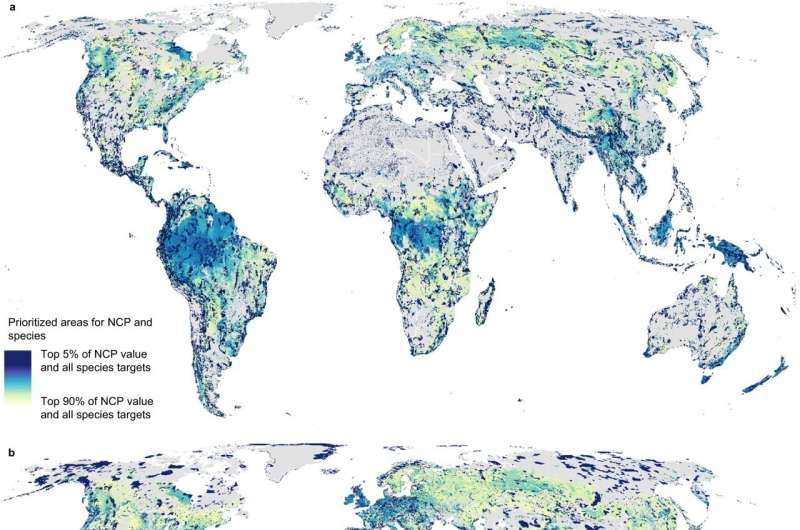This article has been reviewed according to Science X's editorial process and policies. Editors have highlighted the following attributes while ensuring the content's credibility:
fact-checked
peer-reviewed publication
trusted source
proofread
Most of the land humans need to thrive is unprotected, new study finds

More than 80% of global land area needed to maintain human well-being and meet biodiversity targets is at risk of conflict with human development, according to a new study led by the Cornell Lab of Ornithology.
The study, published Jan. 10 in Nature Communications, found that roughly half of global land, excluding Antarctica, provides nearly all current levels of nature's services to people while also conserving biodiversity for 27,000 species of birds, mammals, reptiles and amphibians. Of that, only 18% is adequately protected, the study found.
"Biodiversity, climate and sustainable development cannot be considered in isolation," said lead author Rachel Neugarten, a doctoral student at the Cornell Lab. "We must also factor in nature's contributions to human well-being, including clean water, carbon storage, crop pollination, flood mitigation, coastal protection and more."
These findings point to potential conflict because 37% of the land areas that provide nature's services are also highly suitable for development by agriculture, renewable energy, oil and gas, mining or urban expansion. The potential for development, coupled with the fact that few priority areas are currently protected, means that successful conservation will require creative solutions, such as sustainable use and multifunctional landscape planning.
"We face enormous challenges," said senior author Amanda Rodewald, the Garvin Professor and Senior Director of the Center for Avian Population Studies at the Cornell Lab. "With limited resources available to address climate change, biodiversity loss, poverty and water insecurity, we must be strategic and find ways to tackle more than one challenge at a time."
This study is based on a global-scale optimization of land uses to identify joint priorities for biodiversity and nature's contributions to people.
"If designed carefully, renewable energy development can be compatible with biodiversity conservation and ecosystem services to people," Neugarten said. "Examples of this include livestock grazing under wind farms or cultivating native pollinator gardens under solar panels. But there's a real risk that achieving renewable energy goals could conflict with nature conservation goals without careful planning."
More information: Rachel A. Neugarten et al, Mapping the planet's critical areas for biodiversity and nature's contributions to people, Nature Communications (2024). DOI: 10.1038/s41467-023-43832-9
Journal information: Nature Communications
Provided by Cornell University


















